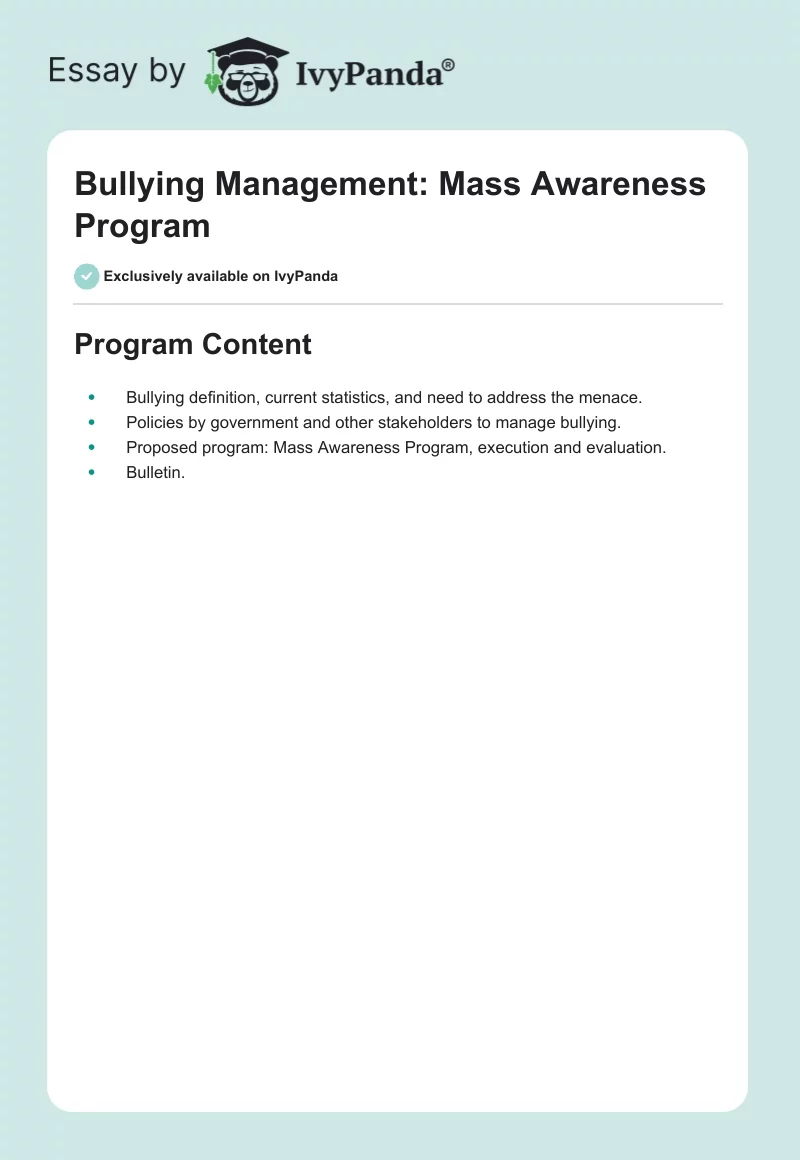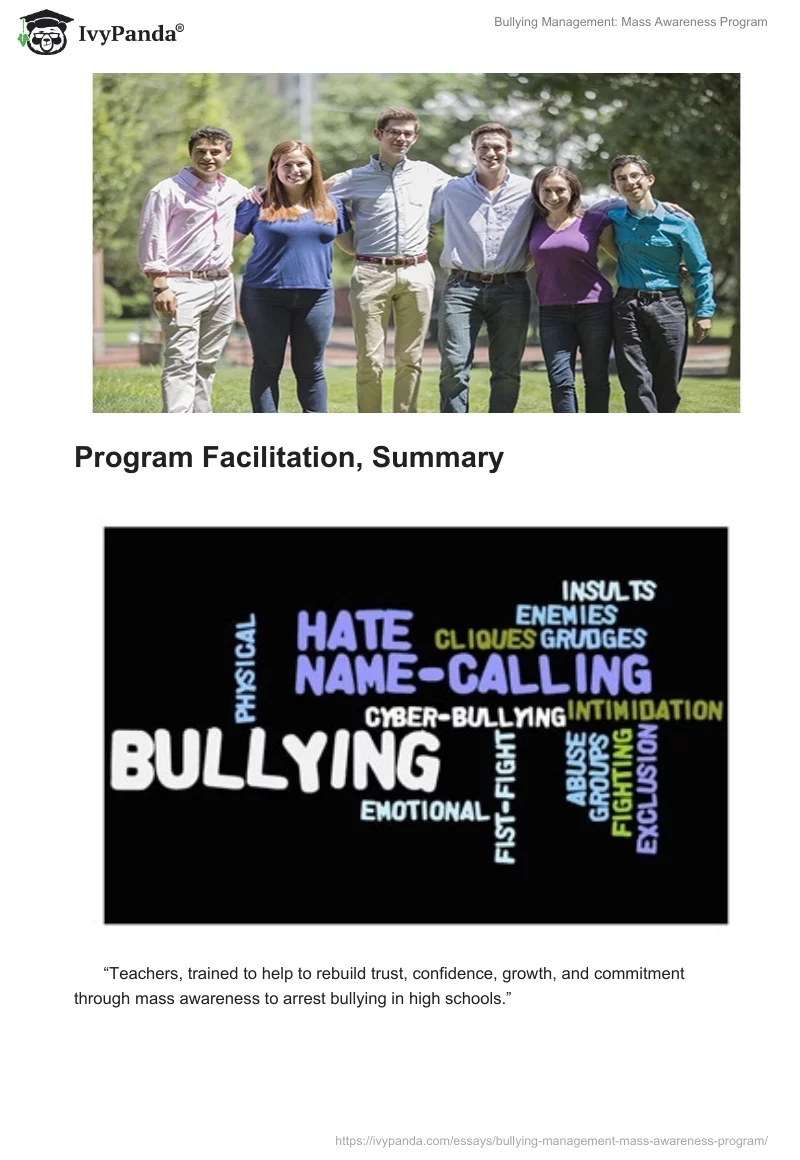Program Content
- Bullying definition, current statistics, and need to address the menace.
- Policies by government and other stakeholders to manage bullying.
- Proposed program: Mass Awareness Program, execution and evaluation.
- Bulletin.
Program Facilitation, Summary
“Teachers, trained to help to rebuild trust, confidence, growth, and commitment through mass awareness to arrest bullying in high schools.”
Scope of the program
The proposed mass action program is meant to promote awareness on the need to stop bullying. Besides, it highlights the best strategies that the victim may use to challenge the problem. The program encourages teachers to be in the forefront in promoting inclusivity, objectivity, and proactive approach to managing socialization among the high school learners.
Content of program
The content of the program include but not limited to:
- Policies in place to prevent bullying in high schools.
- Current statistics on bullying in high schools.
- Roles of teachers in addressing the bullying challenge.
- Potential programs to control bullying.
- The best program to manage bullying, implementation, and evaluation.
Proposed Program
The proposed mass awareness program is meant to give the teacher an opportunity to control and manage the socialization environment in the high school environment. Teachers are empowered to promote inclusivity, positive criticism, manage diversity, recognize special needs, and promote equity rather than equality.
Implementing the program
The program strives to make sure that teachers promote awareness about bullying and why it has no place in the high school environment. Should you have any questions or concerns, please contact us at (Insert Phone Number).
Bullying Definition, Current Statistics, and Need to Address the Menace
Bullying Definition
Thomas, Connor, and Scott (2014) define bullying as peer aggression that, outside of power imbalance, includes the features such as intention and repetition. This means that a “bully’s level of aggression will increase if the caretaker continues to tolerate aggressive behaviors toward the child’s peers, siblings, and teachers” (Smokowski & Kopaiz 2014, p. 102).
Current Statistics
The total number of students that have ever experienced bullying constitutes 21.5%. The 5,386,000 students out of the total of 25,013,000 reported being bullied in 2012 globally (U.S. Department of Education 2013), which is already a huge number. Given the fact that a lot of students prefer silencing the situation for a number of reasons the situation is evidently getting out of control (Jones & Augustine 2015).
An analysis carried out lately has shown that 10-20% of children get bullied on the Internet (Australian Institute of Family Studies 2014). At school, the statistics is even worse – 20% male and 13% female students aged 8-18 report being bullied at school (Australian Human Rights Commission 2016).
Need to Address the Menace
Although “schools play a vital role in promoting the intellectual, physical, social, emotional, moral, spiritual and aesthetic development and wellbeing of young Australians” (Ministerial Council on Education, Employment, Training, and Youth Affairs 2008, p. 5), bullying rates reduce the quality of education and affect students’ lives negatively (Ministerial Council on Education, Employment, Training, and Youth Affairs 2008; Kowalski et al. 2014).
Despite numerous measures undertaken so far in order to address the issue, it still continues to be a significant problem in the school environment (Leadbeater et al. 2013; Wolke, Copeland, & Cosetllo 2014). There is a need to address the delicate issue of bullying at school so that the students’ wellbeing could not be jeopardized (New South Wales Department of Education 2016).
Since the subject matter is likely to not only prevent students from acquiring the necessary knowledge and skills but also contribute to the development of a range of psychological issues from depression to social phobias (Thomas, Connor, & Scott 2014).
Policies by Government and Other Stakeholders to Manage Bullying
Policies in Place
The current policies approved by the Australian educational institutions are geared toward managing the emergent conflicts as well as preventing the situations from occurring in the future (Australian Institute of Family Studies 2014, Hudson-Davis et al. 2015). The focus of the policies designed to prevent bullying addresses the emergent issues and designing the environment in the present-day Australia (Australian Human Rights Commission 2016; UNICEF 2016).
The Australian state policies on the promotion of anti-bullying campaigns and strategies point to the necessity to engage parents in the process by enhancing the significance of the “support for the development and wellbeing of young people and their families” (Ministral Council on Education, Employment, Training, and Youth Affairs 2008, p. 10).
Scope of the Policies
The policies address the intrinsic fears and the emotional issues that victims of bullies have. In general terms, the policies enhance awareness on the need to contact the corresponding school authorities, the teacher and the school psychologist being the first choice of the bully victim (Espelage, Rose, & Polanin 2015).
Proposed program: Mass Awareness Program, execution and evaluation
The program is called mass awareness program. Teachers are expected to promote awareness of bullying as a strategy to prevent its occurrence. The program involves using different education materials such as videos, posters, wristbands, and written reports to create awareness (Archimi & Kuntsche 2014).
The teacher should lead in execution and recruit as many learners as possible to create a diverse, self-respecting, and healthy learning environment (Ranta 2013). Evaluation of the program is based on the feedback of the targeted students, in terms of level of satisfaction and perception of the learning environment after every three months (Smokowski & Kopaiz 2014).
Reference List
Archimi, A & Kuntsche, E 2014, ‘Do offenders and victims drink for different reasons? Testing mediation of drinking motives in the link between bullying subgroups and alcohol use in adolescence,’ Addictive Behaviors, vol. 39, no. 3, pp. 713-716.
Australian Human Rights Commission 2016, Children and young people. Web.
Australian Institute of Family Studies 2014, Children who bully at school.
Espelage, D L, Rose, S A & Polanin, J R 2015, ‘Social-emotional learning program to reduce bullying, fighting, and victimization among middle school students with disabilities,’ Remedial and Special Education, vol. 36, no. 5, pp. 299-311.
Hudson-Davis, A, Bourne, P A, Sharpe-Pryce, C, Francis, C, Solan, T, Lewis, D, Watson-Coleman, O, Blake, J A & Donegon, C 2015, ‘The psychology of the bullying phenomenon in three Jamaican public primary schools: a need for a public health trust,’ International Journal of Emergency Mental Health and Human Resilience, vol. 17, no. 2, pp. 406-414.
Jones, R J & Augustine, S M 2015, ‘Creating an anti-bullying culture in secondary schools: characteristics to consider when constructing appropriate anti-bullying programs,’ American Secondary Education, vol. 43, no. 3, pp. 73-84.
Kowalski, R N, Schroeder, A M & Guinetti, J W 2014, ‘Bullying in the digital age: a critical review and meta-analysis of cyberbullying research among youth,’ Psychological Bulletin, vol. 140, no. 4, pp. 1073-1137.
Leadbeater, B J, Sukhawathanakul, P, Smith, A, Thompson, R S Y, Gladstone, E G & Sklar, N 2013, ‘Bullying and victimization in rural schools: risks, reasons, and responses,’ Journal of Rural and Community Development, vol. 8, no. 1, pp. 31-47.
Ministral Council on Education, Employment, Training, and Youth Affairs 2008, Melbourne Declaration on Educational Goals for Young Australians.
New South Wales Department of Education 2016, Cyberbullying prevention – tips for parents. Web.
Ranta, K 2013, ‘Peer victimization and social phobia: a follow-up study among adolescents,’ Social Psychiatry and Psychiatric Epidemiology, vol. 48, no. 4, pp. 533-544.
Smokowski, P R & Kopaiz, K H 2014, ‘Bullying in school: an overview of types, effects, family characteristics, and intervention strategies,’ Children & Schools, vol. 27, no. 2, 101-110.
Thomas, H J, Connor, J P & Scott, J G 2014, ‘Integrating traditional bullying and cyberbullying: challenges of definition and measurement in adolescents – a review,’ Educational Psychology Review, vol. 27, no. 1, pp. 135-152.
UNICEF 2016, Peer violence.
U.S. Department of Education 2013, Student reports of bullying and cyberbullying: results from the 2013 School Crime Supplement to the National Crime Victimization Survey.
Wolke, D, Copeland, W E & Cosetllo, E J 2014, ‘Impact of bullying in childhood on adult health, wealth, crime and social outcomes,’ Psychological Science, vol. 24, no. 10, pp. 1958-1970.


